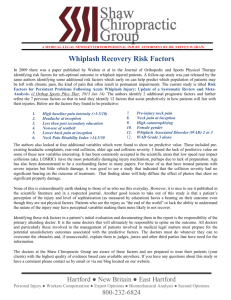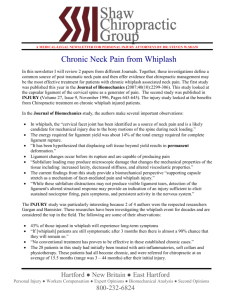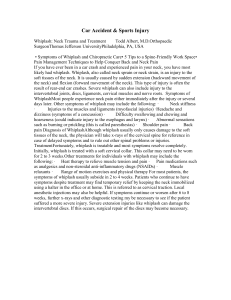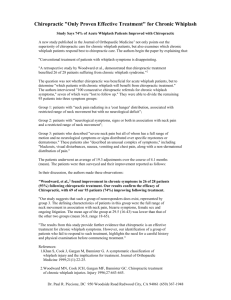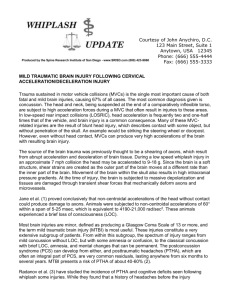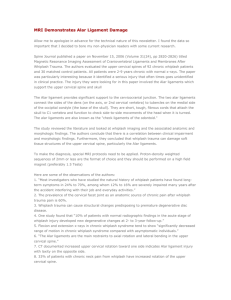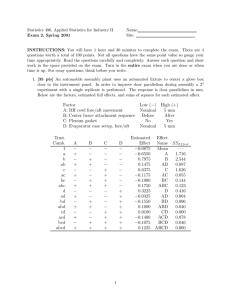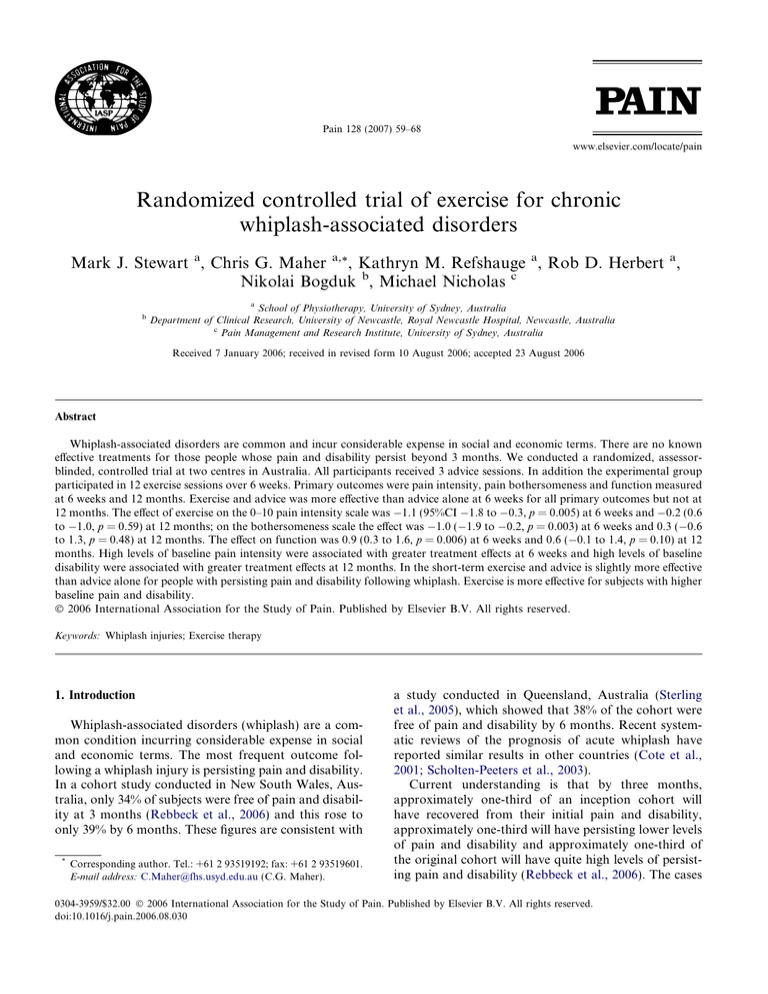
Pain 128 (2007) 59–68
www.elsevier.com/locate/pain
Randomized controlled trial of exercise for chronic
whiplash-associated disorders
Mark J. Stewart a, Chris G. Maher a,*, Kathryn M. Refshauge a, Rob D. Herbert a,
Nikolai Bogduk b, Michael Nicholas c
b
a
School of Physiotherapy, University of Sydney, Australia
Department of Clinical Research, University of Newcastle, Royal Newcastle Hospital, Newcastle, Australia
c
Pain Management and Research Institute, University of Sydney, Australia
Received 7 January 2006; received in revised form 10 August 2006; accepted 23 August 2006
Abstract
Whiplash-associated disorders are common and incur considerable expense in social and economic terms. There are no known
effective treatments for those people whose pain and disability persist beyond 3 months. We conducted a randomized, assessorblinded, controlled trial at two centres in Australia. All participants received 3 advice sessions. In addition the experimental group
participated in 12 exercise sessions over 6 weeks. Primary outcomes were pain intensity, pain bothersomeness and function measured
at 6 weeks and 12 months. Exercise and advice was more effective than advice alone at 6 weeks for all primary outcomes but not at
12 months. The effect of exercise on the 0–10 pain intensity scale was 1.1 (95%CI 1.8 to 0.3, p = 0.005) at 6 weeks and 0.2 (0.6
to 1.0, p = 0.59) at 12 months; on the bothersomeness scale the effect was 1.0 ( 1.9 to 0.2, p = 0.003) at 6 weeks and 0.3 ( 0.6
to 1.3, p = 0.48) at 12 months. The effect on function was 0.9 (0.3 to 1.6, p = 0.006) at 6 weeks and 0.6 ( 0.1 to 1.4, p = 0.10) at 12
months. High levels of baseline pain intensity were associated with greater treatment effects at 6 weeks and high levels of baseline
disability were associated with greater treatment effects at 12 months. In the short-term exercise and advice is slightly more effective
than advice alone for people with persisting pain and disability following whiplash. Exercise is more effective for subjects with higher
baseline pain and disability.
2006 International Association for the Study of Pain. Published by Elsevier B.V. All rights reserved.
Keywords: Whiplash injuries; Exercise therapy
1. Introduction
Whiplash-associated disorders (whiplash) are a common condition incurring considerable expense in social
and economic terms. The most frequent outcome following a whiplash injury is persisting pain and disability.
In a cohort study conducted in New South Wales, Australia, only 34% of subjects were free of pain and disability at 3 months (Rebbeck et al., 2006) and this rose to
only 39% by 6 months. These figures are consistent with
*
Corresponding author. Tel.: +61 2 93519192; fax: +61 2 93519601.
E-mail address: C.Maher@fhs.usyd.edu.au (C.G. Maher).
a study conducted in Queensland, Australia (Sterling
et al., 2005), which showed that 38% of the cohort were
free of pain and disability by 6 months. Recent systematic reviews of the prognosis of acute whiplash have
reported similar results in other countries (Cote et al.,
2001; Scholten-Peeters et al., 2003).
Current understanding is that by three months,
approximately one-third of an inception cohort will
have recovered from their initial pain and disability,
approximately one-third will have persisting lower levels
of pain and disability and approximately one-third of
the original cohort will have quite high levels of persisting pain and disability (Rebbeck et al., 2006). The cases
0304-3959/$32.00 2006 International Association for the Study of Pain. Published by Elsevier B.V. All rights reserved.
doi:10.1016/j.pain.2006.08.030
60
M.J. Stewart et al. / Pain 128 (2007) 59–68
that do not recover by 3 months are responsible for the
majority of whiplash costs (Spitzer et al., 1995). Therefore, treatments that prevent transition to chronicity
or are effective for chronic whiplash have the potential
to significantly reduce social and economic costs.
Very few trials have evaluated interventions for
patients with chronic whiplash i.e. pain and disability
that persists beyond three months. In a recent systematic
review of conservative treatment (Stewart, 2005) we
were only able to locate two trials. One study was of
low quality (Fitz-Ritson, 1995) and the other was underpowered (Soderlund and Lindberg, 2001) so firm conclusions about treatment effectiveness were not
possible. The only known effective treatment for chronic
whiplash is radiofrequency neurotomy (Lord et al.,
1996), however this technique is only known to be effective for the subgroup of patients whose symptoms are
shown by diagnostic blocks to arise from the lower
cervical zygapophyseal joints.
Faced with a lack of known effective treatments for
long-term pain and disability following whiplash, clinicians have adopted treatments that are known to work
for other forms of chronic spinal pain. As there is evidence that exercise is effective for patients with persisting
low back pain (Cost B13, 2004; Hayden et al., 2005), this
treatment has been used for patients with chronic whiplash. While there is some logic to this practice, evidence
for the lumbar spine cannot be confidently extrapolated
to the cervical spine, particularly after a traumatic injury
such as whiplash. We therefore directly tested the effectiveness of exercise treatment for people who had sustained a whiplash injury and had ongoing pain and
disability that had persisted for greater than three
months.
The study aimed to compare the effectiveness of exercise and advice with advice alone for people with persisting pain and disability following a whiplash injury. The
study also investigated whether there were characteristics of patients that moderated the effect of exercise
treatment.
2. Methods
2.1. Study sites
The trial was conducted at two physiotherapy clinics in
Sydney, Australia. The enrolment period was from December
2001 to January 2004. The study protocol was approved by the
Human Research Ethics Committee of the University of Sydney and has been published (Stewart et al., 2003).
2.2. Participants
To be eligible for inclusion, participants must have presented for medical care of a whiplash-associated disorder grades
I–III within one month of the accident. Participants must also
have reported that they were at least ‘‘mildly’’ disabled with
respect to pre-injury status and have had significant pain or
disability as indicated by a score of at least 20% on any one
of the primary outcome measures. Participants were recruited
by sending letters to claimants who had a whiplash injury at
least 3 but not greater than 12 months earlier based upon lists
of claimants provided to the authors by the Motor Accident
Authority of New South Wales. Exclusion criteria were previous neck surgery, known or suspected serious pathology, nerve
root compromise (i.e., whiplash is currently grade III), contraindication to exercise (ACSM, 1995) severe or greater depressive symptoms as measured by the Depression Anxiety Stress
Scale (DASS), no neck radiograph obtained since the accident
and current physiotherapy neck treatment. Because of the
importance of clear understanding of the messages contained
within the advice sessions, subjects with poor English comprehension were excluded from the study. Prior to entry to the
trial, consent was obtained from all participants.
2.3. Randomization
After completing the baseline assessment, participants were
randomly allocated to one of two intervention groups: exercise
and advice or advice alone. The allocation schedule was generated by a person not involved in the trial and placed in sequentially numbered, sealed, opaque envelopes. The trial
coordinator handed the next-numbered envelope to the treating physical therapist who then opened the envelope out of
sight of the trial coordinator. Participants were considered to
have been randomized and to have entered the trial at the time
the envelope was opened. This process ensured allocation was
concealed from participants, referring medical practitioners,
trial staff who determined eligibility, and the assessor of
outcomes.
2.4. Treatments
After baseline measures were taken by the trial coordinator,
subjects were comprehensively assessed by the treating physiotherapist who took a complete history and performed a physical examination. During this assessment, current and pre-injury
ability to perform work and home activities were established
and measures of upper and lower body mobility, coordination,
strength and aerobic fitness were taken. On the basis of this
assessment and using the baseline measures, each subject was
given advice (as below). Randomization to treatment group
occurred after this advice had been given.
2.4.1. Advice
Subjects in the advice group received standardised education, reassurance and encouragement to resume light activity
alone. The advice was given in one consultation and two follow-up phone contacts. The treating physiotherapist emphasised the favourable prognosis of whiplash and addressed
common inaccurate beliefs about whiplash. Subjects were told
that physical activity, even that which evokes moderate pain, is
unlikely to further damage the neck and back, and that excessive voluntary limitation of activity may cause muscle weakness and impede recovery. The physiotherapist explored and
discussed the patient’s understanding of whiplash and attitudes
and beliefs about activity resumption (e.g. fear of increased
pain or re-injury) that may have imposed barriers to recovery.
M.J. Stewart et al. / Pain 128 (2007) 59–68
Subjects were given a written report covering the main points
of the advice session. Two and four weeks later subjects were
contacted by telephone and the standardised advice was
reinforced.
2.4.2. Exercise
The six-week graded exercise program was carried out
under supervision from a physiotherapist (3 sessions in the
first and second weeks; 2 sessions in the third and fourth
weeks; and 1 session in the fifth and sixth weeks). Each session consisted of 1 h of exercises, 30 min of which was supervised by the therapist. The exercise program was an
individualized, progressive, submaximal program designed to
improve participants’ ability to complete functional activities
specified by the participant as being difficult because of whiplash. Each participant carried out a form of aerobic exercise
(e.g., a walking or cycling program), stretches, functional
activities, activities to build speed, endurance and coordination, and trunk and limb strengthening exercises. The therapist used principles of cognitive behavioral therapy
including setting goals of progressively increasing difficulty,
shaping, encouraging self-monitoring of progress and self-reinforcement (Nicholas and Tonkin, 2005). Participants were
also given an individualized home exercise program that
was regularly evaluated by the physiotherapist, and they were
encouraged to continue the home program after the intervention period finished.
To ensure consistent administration of treatments, a treatment manual was developed and each physiotherapist was
trained in the study protocol and interventions. Physiotherapists were educated by an experienced clinical psychologist
about the principles of the cognitive behavioral approach. In
addition, one of the investigators regularly visited each treatment site to monitor delivery of treatment.
Treatment compliance was established by recording the
number of appointments attended, session duration and the
amount of time spent with each participant. Participants were
discouraged from seeking other health care during the 6-week
treatment period. Participants who discontinued treatment
were encouraged to return for follow-up assessments.
61
measured with the Neck Disability Index, score range 0–50.
Health-related quality of life was measured by the physical
and mental summary scores of the SF36.
At both 6 weeks and 12 months, information about adverse
effects of treatment was sought from all subjects using openended questioning. In addition, subjects’ perceptions of the
credibility of intervention were assessed at 6 weeks by questionnaire. Compliance with the activity program was also
assessed at 6 weeks by examining attendance records and exercise diaries. Use of treatment (other than that provided as part
of the trial) was also assessed at 6 weeks and 12 months by
questionnaire.
Outcomes were administered and scored by staff blinded to
treatment group, but treatment outcomes were self-assessed by
participants so complete assessor-blinding was not possible.
2.6. Statistical analysis
Sample size was determined a priori with analyses comprehensively described in the trial protocol (Stewart et al., 2003).
Data were double-entered and then analyzed by a blinded statistician, (author RH) on an intention-to-treat basis. Analysis
followed a published protocol specified a priori. The only variation to the published protocol (Stewart et al., 2003) was to
use logistic regression rather than Cox regression to analyze
work status data. A few participants did not complete every
item in a questionnaire. When this occurred missing items were
substituted by the average item score of the questionnaire or
subscale (for that participant). Participants were omitted from
the analysis if all follow-up data were missing.
Effects of treatment were analyzed using a linear regression
approach to analysis of covariance. We specified a priori that
baseline scores of each outcome would be entered as a covariate in the analysis of that outcome. In secondary analyses we
evaluated whether patient characteristics, all specified a priori,
moderated the effect of treatment. This was accomplished by
adding a term to each regression model for the interaction
between the putative moderator variable and group membership. The emphasis was on point and interval estimation, but
we also conducted hypothesis tests. The test-wise Type I error
rate was set at 0.05.
2.5. Outcome measures
Immediately prior to randomization, demographic,
historical and social data were collected as well as treatment outcome measures. Six weeks and 12 months after
randomization, additional data were collected on medication use, side-effects, adverse events and number and type
of co-interventions.
Primary and secondary outcome measures were nominated
a priori (Stewart et al., 2003). The primary outcomes were pain
intensity, pain bothersomeness and functional ability at 6
weeks and 12 months. Secondary outcomes were disability,
global perceived effect, health-related quality of life and work
status at 6 weeks and 12 months.
Pain intensity and bothersomeness were both rated as the
average over the last 24 h rated on a 0–10 box scale. Functional ability was measured using the Patient-Specific Functional
Scale, range 0–10. Global perceived effect was measured on
an 11-point scale, ranging from 5 (vastly worse) to 5 (completely recovered), with 0 being unchanged. Disability was
3. Results
3.1. Recruitment and follow-up of participants
Letters were sent to 4889 potential participants.
There were 297 respondents of whom 163 were ineligible
(Fig. 1). Of the 134 participants randomized, 132 (99%)
attended the 6-week follow-up and 125 (93%) attended
the 12 month follow-up.
3.2. Baseline characteristics
The groups were similar at baseline (Table 1). Participants had moderate levels of pain and fear avoidance, were mildly disabled and distressed and were
generally confident that the two treatments would
be helpful.
62
M.J. Stewart et al. / Pain 128 (2007) 59–68
Fig. 1. Flow chart of whiplash trial.
3.3. Compliance with treatment
The mean number of exercise sessions attended was
9.9 (range 0–12 sessions) of the maximum 12 sessions.
The mean number of advice sessions was 2.9 (range
1–3 sessions).
3.4. Other treatments
3.4.1. Additional treatment during intervention period
(0–6 weeks)
Fifteen subjects (23%) in the advice group reported
seeking additional treatment during the intervention
period despite encouragement to refrain from extra
therapy during the period. Of these, nine subjects
attended physiotherapy, two attended massage therapy,
one began a gym program, one had chiropractic treatment and one subject had both physiotherapy and chiropractic treatment and one subject did not specify the
treatment. In the advice plus exercise group, 10 subjects
(15%) sought additional treatment during the treatment
period. Three subjects sought chiropractic treatment
and massage, one sought other physical therapy treatment and massage, one sought other physical therapy
treatment, one attended hydrotherapy, one attended
acupuncture treatment, one attended Pilates classes,
one attended work conditioning and one attended
massage therapy.
M.J. Stewart et al. / Pain 128 (2007) 59–68
63
Table 1
Baseline characteristics of study population
Variable
Advice Group (N = 68)a
Advice plus exercise group (N = 66)
All subjects (N = 134)a
Age (years)
Gender (count and %)
Duration of Symptoms (months)
Pain (0–10 scale)
Bothersomeness (0–10 scale)
PSFS Averageb (0–10 score)
GPEc ( 5 to 5)
NDId (0–50)
DASS21e
Advice expectationf (0–10 scale)
Exercise expectationg (0–10 scale)
Tampah (0–68 scale)
SF36 – Physical summary score
SF36 – Mental summary score
42.7 (14.4)
41F (62%)
8.6 (2.5)
5.3 (2.0)
7.1 (2.3)
4.1 (1.6)
0.3 (2.4)
19.7 (6.9)
8.4 (9.3)
6.9 (2.8)
8.2 (2.2)
41.0 (7.7)
36.8 (8.6)
48.0 (11.4)
43.9 (15.1)
48F (73%)
9.5 (2.1)
5.2 (2.0)
6.8 (2.4)
3.9 (1.7)
0.6 (2.4)
18.2 (6.3)
8.1 (9.0)
6.9 (2.5)
8.0 (1.9)
38.3 (7.8)
36.4 (9.9)
49.0 (11.0)
43.3 (14.7)
89F (66%)
9.0 (2.4)
5.3 (2.0)
7.0 (2.3)
4.0 (1.6)
0.5 (2.4)
19.0 (6.6)
8.3 (9.1)
6.9 (2.7)
8.1 (2.0)
39.7 (7.8)
36.7 (9.3)
48.7 (11.0)
Data are means and SDs except where indicated.
a
Data include 2 subjects in advice group who dropped out of study after randomization (6 week data not obtained).
b
Patient-Specific Functional Scale score (average of 3 scores, all out of 10, 0 representing unable to perform activity, 10 representing able to
perform activity at pre-injury level).
c
Global Perceived Effect Score ( 5 representing vastly worse, 0 representing unchanged, 5 representing completely recovered).
d
Neck Disability Index Score (0–50 scale, 10 items, higher scores represent greater disability).
e
DASS 21 Score (21 items, depression score only shown. Scale range 0–42 score).
f
Patient perception of advice treatment. Question asked ‘‘How helpful do you believe advice alone will be for your whiplash problems?’’ (0–10
scale, 0 representing not at all helpful, 10 representing extremely helpful).
g
Patient perception of exercise treatment. Question asked ‘‘How helpful do you believe advice plus an exercise program will be for your whiplash
problems?’’ (0–10 scale, 0 representing not at all helpful, 10 representing extremely helpful).
h
Tampa score (17–68 scale, 17 items, higher scores represent greater fear avoidance).
3.4.2. Additional treatment during follow-up year (6
weeks–12 months)
Thirty-five subjects (56%) in the advice group sought
additional treatment during the 12 month follow-up
period. Of these, 17 had further physiotherapy, five
had massage, four had chiropractic treatment, two had
osteopathic treatment, two attended hydrotherapy
(one of these in conjunction with a prescribed gym program), two had acupuncture (one of these in conjunction with massage therapy), one attended a work
conditioning program, one consulted multiple practitioners including a physiotherapist, a massage therapist
and a chiropractor, and one subject made use of magnetic therapy. Eighteen subjects (29%) in the exercise
group sought additional treatment during the 12 month
follow-up period. Six had further physiotherapy, seven
had massage therapy (one in conjunction with hydrotherapy and one in conjunction with facet joint injections), two had chiropractic treatment, one had
acupuncture, one attended a work conditioning program and one subject attended hydrotherapy.
The primary analysis compared effects of exercise and
advice with advice alone on pain intensity, pain bothersomeness and patient-specific function at the 6-week and
12-month follow-ups (shaded cells in Table 2). The
effects of exercise (i.e. the adjusted difference in outcomes between exercise and advice and advice on a 0–
10 scale) at 6 weeks were 1.1 (95%CI 1.8 to 0.3,
p = 0.005) for pain intensity, 1.0 ( 1.9 to 0.2, p =
0.003) for pain bothersomeness, and 0.9 (0.3–1.6,
p = 0.006) for patient-specific function. These effects
were smaller and no longer statistically significant at
12 months.
The secondary analysis showed that exercise and
advice was more effective than advice alone in reducing
disability, improving health-related quality of life (SF36
physical and mental summary scores), and had a greater
global perceived effect. With the possible exception of
global perceived effect the effects were very small at 6
weeks; and at 12 months all were smaller and no longer
statistically significant. There was no effect of exercise
and advice treatment on employment status at 6 weeks
or 12 months (Table 3).
3.5. Effectiveness of treatment
3.6. Adverse events
All groups improved on average on the primary and
secondary outcomes from baseline to 6 weeks but the
improvements from 6 weeks to one year were more
modest (Table 2).
There were no instances in this trial where subjects
required referral to a medical practitioner for adverse
effects due to participation in the trial. At 6 weeks
64
M.J. Stewart et al. / Pain 128 (2007) 59–68
Table 2
Mean (SD) for outcome measures at baseline, 6 weeks, and 12 months and effects of exercise vs advice
subjects were asked if they had suffered any adverse
effects arising from participation. Twelve subjects
(18%) in the advice group answered ‘yes’ to this ques-
tion. The main complaint was muscle pain (4) followed
by an increase in headaches (2) and ongoing pain (2).
Thirteen subjects (20%) in the advice plus exercise group
Table 3
Employment status
Full time/full duties
Full time/some duties
Part time/full duties
Part time/some duties
Not working/employed
Not working/employed/retraining
Not working/unemployed/retraining
Not working/unemployed
Time of accident
Baseline
Advice
(n = 68)
Exs
(n = 66)
Advice
(n = 68)
Exs
(n = 66)
6 weeks
Advice
(n = 66)
Exs
(n = 66)
12 months
Advice
(n = 66)
Exs
(n = 66)
46 (68%)
1 (1%)
8 (12%)
2 (3%)
0 (0%)
0 (0%)
0 (0%)
11 (16%)
37 (56%)
0 (0%)
12 (18%)
0 (0%)
1 (2%)
0 (0%)
0 (0%)
16 (24%)
30 (44%)
7 (10%)
5 (7%)
8 (12%)
2 (3%)
0 (0%)
0 (0%)
16 (24%)
25 (38%)
0 (0%)
8 (12%)
5 (8%)
2 (3%)
0 (0%)
0 (0%)
26 (39%)
34 (52%)
4 (6%)
7 (11%)
7 (11%)
2 (3%)
0 (0%)
0 (0%)
12 (18%)
27
0
7
5
0
0
0
27
31 (50%)
2 (3%)
8 (13%)
5 (8%)
2 (3%)
0 (0%)
0 (0%)
14 (23%)
24 (38%)
1 (1.5%)
9 (14%)
6 (9.5%)
0 (0%)
0 (0%)
2 (3%)
21 (33%)
(41%)
(0%)
(11%)
(8%)
(0%)
(0%)
(0%)
(41%)
Number (percentage) in each employment category at time of accident, at trial entry, at 6 week follow up and at 12 month follow up.
M.J. Stewart et al. / Pain 128 (2007) 59–68
65
Table 4
Treatment credibility
How confident do you feel that this treatment can relieve your pain?
How confident do you feel that this treatment will help you manage your pain?
How confident would you be in recommending this treatment to a
friend who suffered from similar complaints?
How logical does this type of treatment seem to you?
Advice (n = 66)
Advice plus
exercise (n = 66)
2.84 (2.11)
3.09 (2.12)
3.32 (2.36)
4.54 (1.35)
4.79 (1.27)
5.35 (1.14)
3.85 (2.25)
5.36 (1.03)
Mean (SD) treatment credibility ratings, each item is rated on a scale from 0 to 6. For all items unpaired t tests were statistically significant.
answered ‘yes’ to this question. The main complaint in
this group was muscle pain with exercise (3) followed
by knee pain (2) and lumbar spine pain (2).
3.7. Treatment credibility
There was a significant difference between groups on
all 4 measures of treatment credibility with subjects in
the exercise group perceiving treatment to be more credible than those in the advice group (p < 0.0001 on all 4
questions) (Table 4).
3.8. Prediction of response to treatment
Predictors of response to treatment are shown in
Table 5. High levels of baseline pain intensity were associated with greater effects of exercise on the intensity and
bothersomeness of pain at 6 weeks and high levels of
baseline disability were associated with greater treatment effects at 12 months.
3.9. Post hoc analyses
A journal reviewer requested that we assess the impact
of the treatment credibility ratings and use of additional
health care on outcomes as these differed between groups.
To assess the influence of additional health care use we
repeated our analysis of the 6-week and 12-month outcomes adding the ‘use of additional health care variable’
to the treatment effectiveness regression equations (and
so controlling for this in the analysis). This did not change
the original results: there remained an effect of treatment
group at 6 weeks, but not 12 months, for all 7 outcomes
after controlling for use of additional health care. To
assess the influence of treatment credibility the four individual treatment credibility items were summed to create
a single treatment credibility variable that was entered
into the treatment effectiveness regression equations. This
substantially changed the original results: there was now
no longer an effect of treatment group at 6 weeks for
any of the 7 outcomes and at 12 months there was a marginally significant effect (p = 0.033) for one outcome.
At the request of the same reviewer we also evaluated
whether duration of symptoms was a predictor of
response to treatment. To do this we added the interaction term, duration of whiplash · treatment group, to
the regression equation used to evaluate effectiveness
of treatment. For all primary outcomes at 6 weeks and
12 months the duration of whiplash was not a predictor
of response to treatment.
Table 5
Magnitude of treatment response
Factors influencing magnitude of treatment response
Baseline pain
Baseline disability
Baseline fear of movement
6 weeks
Pain intensity
Pain bothersomeness
Function
0.38 ( 0.74, 0.02), p = 0.037
0.50 ( 0.90, 0.10), p = 0.016
0.17 ( 0.14, 0.49), p = 0.28
0.26 ( 0.71, 0.18), p = 0.24
0.27 ( 0.77, 0.25), p = 0.31
0.11 ( 0.29, 0.51), p = 0.58
0.03 ( 0.13, 0.06), p = 0.51
0.08 ( 0.19, 0.04), p = 0.18
0.08 ( 0.01, 0.17), p = 0.07
12 months
Pain intensity
Pain bothersomeness
Function
0.22 ( 0.63, 0.19), p = 0.29
0.42 ( 0.87, 0.04), p = 0.073
0.29 ( 0.08, 0.67), p = 0.127
0.59 ( 1.11, 0.07), p = 0.028
0.46 ( 1.05, 0.12), p = 0.118
0.15 ( 0.60, 0.30), p = 0.518
0.04 ( 0.16, 0.08), p = 0.492
0.06 ( 0.19, 0.07), p = 0.360
0.08 ( 0.02, 0.19), p = 0.108
Pain intensity and bothersomeness were both rated as the average over the last 24 h on a 0–10 box scale. Function measured using Patient-Specific
Functional Scale score (Average of 3 scores, all out of 10, 0 representing unable to perform activity, 10 representing able to perform activity at preinjury level). Fear of movement using the Tampa score (Vlaeyen et al., 1995).
Effect of adding putative effect modifiers to regression equation. Data are regression coefficients with 95%CI.
66
M.J. Stewart et al. / Pain 128 (2007) 59–68
4. Discussion
This study provides the first rigorous test of exercise
and advice as treatments for people who have sustained
a whiplash injury and have ongoing pain and disability
that persists beyond three months. Compared with
advice alone, exercise produced small reductions in pain
intensity and bothersomeness, and small improvements
in function, disability, quality of life and global perceived effect for people with mildly disabling chronic
whiplash at 6-weeks follow-up. These effects were not
apparent at 12 months. Individuals with high initial levels of pain and disability improved to a greater extent
with exercise than those with low levels.
A critical issue is whether the magnitude of the effects
of exercise is clinically worthwhile. Short-term effects of
exercise on pain, bothersomeness of symptoms and disability at 6 week follow-up were of a similar magnitude.
Farrar et al. (2001) reported that a difference of 1 point
on a 0–10 pain scale was the threshold for patients to
consider themselves to be at least ‘‘minimally
improved’’. Similar results have been reported by Kelly
(2001) and Bijur et al. (2003). Furthermore Farrar et al.
(2001) estimated that an improvement of 1.7 points was
the threshold for ‘‘much improved’’. In the current
study, subjects in the advice group improved by 1.0
point from baseline and subjects in the exercise group
improved by 2.0 points from baseline on a 0–10 pain
scale. The effect of exercise was therefore equivalent to
a change from ‘‘minimally improved’’ to ‘‘much
improved’’ and is likely to be considered worthwhile
by many patients with chronic whiplash, particularly
because there are no other evidence-based treatments
available for this traditionally treatment-resistant
patient group.
Only two physical treatments have been investigated
in randomized controlled trials for patients with chronic
whiplash, exercise and cognitive behavioral therapy. Prior to this study, there were only one randomized controlled trial that specifically investigated the use of
exercise in patients with chronic whiplash (Fitz-Ritson,
1995). However the findings of that study should be
interpreted with caution because of the poor methods
(non-blinded, lack of baseline comparability, no intention-to-treat analysis) and the lack of description of
the exercise. The authors concluded that ‘phasic’ exercises in conjunction with chiropractic treatment were more
effective than ‘rehabilitation’ exercises and chiropractic
treatment. A further randomized controlled trial investigated a cognitive behavioral therapy approach in the
treatment of chronic whiplash (Soderlund and Lindberg,
2001). In that study, Soderlund and Lindberg (2001)
compared cognitive behavioral therapy and standard
physiotherapy program with standard physical therapy
alone and found that there was no statistically or clinically significant differences in primary pain or disability
outcomes between the treatment groups (Soderlund and
Lindberg, 2001). Unfortunately only 33 subjects participated in this study and while the authors noted trends
in favor of the cognitive behavioral therapy group, the
study lacked the statistical power necessary to demonstrate a clinically significant difference between the two
groups. It is also worth noting that both groups received
supervised active treatments in the physiotherapy program involving neck and shoulder strength and stability
exercises, range of motion, stretching and muscular
coordination exercises.
The only therapy for chronic whiplash currently
known to be effective appears to be radiofrequency neurotomy (Lord et al., 1996) however this treatment is
technically difficult to administer proficiently and is
not appropriate for all chronic whiplash sufferers. In
light of the lack of evidence-based therapy the results
of the current study should be viewed with some optimism. The challenge is how to adjust the dose of the
exercise program in order to increase both the size of
the treatment effect and the durability of the effect.
Changing the intensity and/or duration of the initial
exercise program or adding follow-up reminder phone
calls and/or face-to-face consultations are options we
are currently considering.
A secondary aim of this trial was to determine if pain
severity, level of disability or fear of movement predicted
response to the physical activity program. There was a
statistically significant effect of both initial pain and disability on treatment outcomes. Subjects with higher initial
levels of pain and disability experienced a greater treatment effect than subjects with lower levels. This is an
important finding for patients, clinicians and insurers
alike. Chronic whiplash patients with high levels of pain
and disability potentially have a worse prognosis than
those with lower levels of pain (Cote et al., 2001;
Scholten-Peeters et al., 2003). Subjects in the exercise
group clearly thought the treatment they received was
more credible and logical than did patients in the advice
group (Table 4). This finding may be due either to the type
or amount of treatment received. This finding is similar to
that of Bronfort et al. (2001), who found that subjects
were more satisfied with spinal manipulative therapy supplemented by exercise than with spinal manipulative therapy alone. Similarly Taimela et al. (2000) found active
intervention was more effective in terms of self-reported
benefits than education about neck pain and advice to
exercise. These findings might suggest that patients who
take an ‘‘active’’ role in treatment may be more satisfied
than subjects who remain ‘‘passive’’, or alternately that
subjects who receive a greater amount of treatment may
be more satisfied with that treatment.
A further indicator that subjects in the exercise group
were more satisfied with treatment was the difference in
numbers of subjects in each group seeking additional
treatment during the course of the trial. Subjects in the
M.J. Stewart et al. / Pain 128 (2007) 59–68
advice group were more likely to seek other treatment
during the treatment period and the subsequent 12
months. This indicates that simple advice may not be
as economical as it would first seem. The number of subjects in the advice group who sought additional treatment indicates that either these individuals did not feel
that the treatment was helping them adequately or they
did not feel that they were receiving sufficient treatment.
The cost of the additional treatment (which was extensive in some cases) should be considered before recommending chronic whiplash be treated with advice alone.
The first of the post hoc analyses requested by the
reviewer demonstrated that after controlling for the
use of other treatments, exercise and advice was still
not more effective than advice alone at 12 months. It
is perhaps not surprising that controlling for the use of
other treatments did not affect the results because there
are no known effective treatments for whiplash beyond
radiofrequency neurotomy. If this post hoc analysis
did substantially change the effectiveness analysis it
would be of interest to researchers attempting to understand the results of this trial but of little or no relevance
to clinicians wishing to apply these treatments in clinical
practice. The reason for this is that it is not possible or
ethical to prevent patients seeking other treatments.
The second post hoc analysis revealed that after controlling for treatment credibility in the treatment effectiveness analyses there was no longer an effect of
treatment group at 6 weeks. This result does not change
our conclusion that combined exercise and advice treatment is more effective than advice alone however it does
offer an insight into why combined exercise and advice is
more effective. While it is tempting to view this result as
evidence that patients’ perceptions of treatment credibility influence outcome it is also possible to argue that
outcome influences patients’ perceptions of treatment
credibility. The latter position is tenable because treatment credibility ratings were taken at the end of the 6
week treatment program. Further research is required
to clarify the direction of this relationship. We would
also caution that the treatment credibility result has limited application to clinicians attempting to decide on
appropriate individualized treatment options for their
patients. The first limitation is that in our trial treatment
credibility ratings were taken at the end of the 6 week
treatment program and so unavailable to the clinician
at the time of selecting therapy. Secondly, we analyzed
predictors of outcome, and this is a separate issue to predicting response to treatment. It is the latter which is
important when selecting treatment.
The last post hoc analysis requested by the reviewer
examined whether subjects with a greater duration of
symptoms were less likely to respond to exercise treatment than those with a shorter duration. The analysis
demonstrated that the duration of whiplash symptoms
was not a predictor of response to exercise treatment.
67
Because we restricted enrolment to subjects with duration of symptoms of greater than 3 months and less than
12 months it is not possible to exclude the possibility
that people with whiplash symptoms that have persisted
beyond 12 months may be less likely to respond to exercise treatment.
5. Conclusions
The results of this randomized controlled trial indicate that exercise and advice produces better outcomes
than advice alone for people who have sustained a whiplash injury and have ongoing pain and disability that
persist beyond three months. The effect of exercise is
greater in people with high levels of pain and disability
than those with low levels. The superior results with
exercise and advice compared to advice alone are however small and only apparent in the short term. The
small, short-term effect of exercise should be interpreted
in light of the fact that there are very few treatments
known to be effective for this treatment-resistant patient
group. Whether the superior short-term outcomes in the
exercise and advice group, compared to the advice alone
group, are justifiable in terms of treatment and labor
costs is a decision for individual patients, medical practitioners and insurers.
Acknowledgements
This trial was funded by the NSW Motor Accidents
Authority. We thank staff at RehabOne Physiotherapy
for providing the treatment in the trial. A/Prof Chris
Maher’s research fellowship is funded by the National
Health and Medical Research Council of Australia.
References
ACSM. ACSM’s Guidelines for exercise testing and prescription. 5th
ed. Baltimore: Williams and Wilkins; 1995.
Bijur P, Latimer C, Gallagher E. Validation of a verbally administered
numerical rating scale of acute pain for use in the emergency
department. Acad Emerg Med 2003;10:390–2.
Bronfort G, Evans R, Nelson B, Aker P, Goldsmith C, Vernon H. A
randomized clinical trial of exercise and chiropractic spinal
manipulation for patients with chronic neck pain. Spine
2001;26:788–97.
Cost B13 working group. European Guidelines for the Management of
Chronic Non-Specific Low Back Pain, Cost B13 working group on
guidelines for chronic low back pain; 2004.
Cote P, Cassidy D, Carroll L, Frank J, Bombardier C. A systematic
review of the prognosis of acute whiplash and a new conceptual
framework to synthesize the literature. Spine 2001;26:E445–58.
Farrar J, Young J, LaMoreaux L, Werth J, Poole M. Clinical
importance of changes in chronic pain intensity measured on a 11point numerical pain rating scale. Pain 2001;94:149–58.
Fitz-Ritson D. Phasic exercises for cervical rehabilitation after
‘‘whiplash’’ trauma. J Manipulative Physiol Ther 1995;18:21–4.
68
M.J. Stewart et al. / Pain 128 (2007) 59–68
Hayden JA, van Tulder MW, Tomlinson G. Systematic review:
strategies for using exercise therapy to improve outcomes in
chronic low back pain. Ann Intern Med 2005;142:776–85.
Kelly A. The minimum clinically significant difference in visual
analogue scale pain score does not differ with severity of pain.
Emerg Med J 2001;18:205–7.
Lord SM, Barnsley L, Wallis BJ, McDonald GJ, Bogduk N.
Percutaneous radio-frequency neurotomy for chronic cervical
zygapophyseal-joint pain. N Engl J Med 1996;335:1721–6.
Motor Accidents Authority of New South Wales. Whiplash and
the NSW motor accidents scheme. Statistical Information
Paper no 7. Motor Accidents Authority of NSW, Sydney,
2001.
Nicholas MK, Tonkin L. Persisting pain: using cognitive-behavioural
principles for activity-based pain management. Chapter 8. In:
Refshauge K, Gass E, editors. Musculoskeletal physiotherapy.
Clinical science and evidence-based practice. Oxford: Butterworth
Heinemann; 2005.
Scholten-Peeters G, Verhagen A, Bekkering G, van der Windt A,
Barnsley L, Oostendorp R, Hendriks E. Prognostic factors of
whiplash associated disorders: a systematic review of prospective
cohort studies. Pain 2003;104:303–22.
Soderlund A, Lindberg P. Cognitive behavioural components in
physiotherapy management of chronic whiplash associates
disorders (WAD) – a randomized group study. Physiother Theory
Pract 2001;17:229–38.
Spitzer W, Skovron M, Salmi LR, Cassidy J, Duranceau J, Suissa S,
Zeiss E. Scientific monograph of the Quebec Task Force on
Whiplash-Associated Disorders: Redefining ‘whiplash’and its management. Spine 1995;20:1S–73S.
Sterling M, Jull G, Vicenzino B, Kenardy J, Darnell R. Physical and
psychological factors predict outcome following whiplash injury.
Pain 2005;114:141–8.
Stewart M. Treatment of chronic whiplash. PhD Thesis University of
Sydney, Australia; 2005.
Stewart M, Maher C, Refshauge K, Herbert R, Bogduk N, Nicholas
M. Advice or exercise for chronic whiplash disorders? Design of a
randomized controlled trial. BMC Musculoskelet Disord
2003;4:18.
Taimela S, Takala E, Asklof T, Seppala K, Parviainen S. Active
treatment of chronic neck pain: a prospective randomised intervention. Spine 2000;25:1021–7.
Rebbeck T, Sindhusake D, Cameron I, et al. A prospective cohort
study of health outcomes following whiplash associated disorders
in an Australian population. Injury Prevent 2006;12:86–93.
Vlaeyen J, Kole-Snijders A, Boersen R, van Eek H. Fear of movement/
(re)injury in chronic low back pain and its relation to behavioural
performance. Pain 1995;62:363–72.

